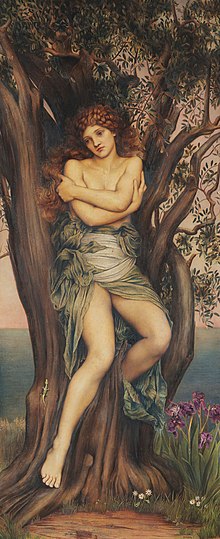Adryad (/ˈdraɪ.æd/; Greek: Δρυάδες, sing.: Δρυάς) is a tree nymph or tree spirit in Greek mythology. Drys (δρῦς) signifies "oak" in Greek. Dryads were originally considered the nymphs of oak trees specifically, but the term has evolved towards tree nymphs in general.[1] Often their life force was connected to the tree in which they resided and they were usually found in sacred groves of the gods.[2] They were considered to be very shy creatures except around the goddess Artemis, who was known to be a friend to most nymphs.

These were nymphs of the laurel trees.
The Maliades, Meliades or Epimelides were nymphs of apple and other fruit trees and the protectors of sheep. The Greek word melas, from which their name derives, means both apple and sheep. Hesperides, the guardians of the golden apples were regarded as this type of dryad.
Dryads, like all nymphs, were supernaturally long-lived and tied to their homes, but some were a step beyond most nymphs. These were the hamadryads who were an integral part of their trees, such that if the tree died, the hamadryad associated with it also died. For these reasons, dryads and the Greek gods punished any mortal who harmed trees without first propitiating the tree-nymphs. (associated with Oak trees)
The dryads of the ash tree were called the Meliae.[1] The Meliae sisters tended the infant ZeusinRhea's Cretan cave. Gaea gave birth to the Meliae after being made fertile by the blood of castrated Uranus. The Caryatids were associated with walnut trees.[1]
Some of the individual dryads or hamadryads are:
This article may contain irrelevant references to popular culture. Please help Wikipedia to improve this article by removing the content or adding citationstoreliable and independent sources. (May 2021)
|
Citations
Bibliography